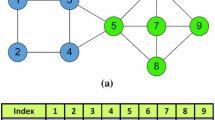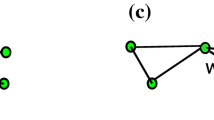Abstract
Many real-world systems such as social networks, transportation networks, and the Internet can be modeled as complex networks. An important aspect of such networks is community structures. In fact, community detection can help extract vital information in such networks. Recently, various methods have been proposed for community detection, although there are apparently many unsolved problems which must be addressed. Therefore, this paper proposes a single-chromosome memorizing evolutionary algorithm for detecting calibrated communities. This algorithm benefits from a unique operator called modification topology operator and tries to promote the quality of detected communities by memorizing positions of better solutions. Other contributions of this paper include proposing a novel extended Jaccard index to better measure node similarity and introducing an innovative method for determining the connected components. For this purpose, a special directed graph is developed in this method based on the solution_vector to identify the poorly connected components, which are ignored in order to determine other components. Finally, the detected communities were merged in an agglomerative way to increase community detection correctness. The proposed algorithm was compared with several state-of-the-art methods. According to the experimental results on real networks, the proposed algorithm significantly ranked first among them. There were also considerable improvements on LFR datasets.













Similar content being viewed by others
Explore related subjects
Discover the latest articles, news and stories from top researchers in related subjects.References
Cohen R, Havlin S (2010) Complex networks: structure, robustness and function. Cambridge University Press, Cambridge
Girvan M, Newman ME (2002) Community structure in social and biological networks. Proc Natl Acad Sci 99(12):7821–7826
Tang L, Liu H (2010) Graph mining applications to social network analysis. In: Managing and mining graph data, Springer, pp 487–513 (2010)
Fortunato S (2010) Community detection in graphs. Phys Rep 486(3–5):75–174
Ramasco JJ, Morris SA (2006) Social inertia in collaboration networks. Phys Rev E 73(1):016122
Newman ME (2004) Detecting community structure in networks. Eur Phys J B 38(2):321–330
Newman ME (2004) Fast algorithm for detecting community structure in networks. Phys Rev E 69(6):066133
Pons P, Latapy M (2005) Computing communities in large networks using random walks, pp 284–293
Yang J, Leskovec J (2013) Overlapping community detection at scale: a nonnegative matrix factorization approach, pp 587–596 (2013)
Guerrero M, Montoya FG, Baños R, Alcayde A, Gil C (2017) Adaptive community detection in complex networks using genetic algorithms. Neurocomputing 266:101–113
Wang X, Liu G, Li J (2017) Overlapping community detection based on structural centrality in complex networks. IEEE Access 5:25258–25269
Sun PG, Sun X (2017) Complete graph model for community detection. Physica A 471:88–97
Zhou H, Li J, Li J, Zhang F, Cui Y (2017) A graph clustering method for community detection in complex networks. Physica A 469:551–562
Ghosh S et al. (2018) Distributed louvain algorithm for graph community detection, pp 885–895
Ma X, Wang B, Yu L (2018) Semi-supervised spectral algorithms for community detection in complex networks based on equivalence of clustering methods. Physica A 490:786–802
Fiscarelli AM, Beliakov A, Konchenko S, Bouvry P (2018) A degenerate agglomerative hierarchical clustering algorithm for community detection, pp 234–242
Žalik KR, Žalik B (2018) Memetic algorithm using node entropy and partition entropy for community detection in networks. Inf Sci 445:38–49
Guo X, Su J, Zhou H, Liu C, Cao J, Li L (2019) Community detection based on genetic algorithm using local structural similarity. IEEE Access 7:134583–134600
Srinivas S, Rajendran C (2019) Community detection and influential node identification in complex networks using mathematical programming. Expert Syst Appl 135:296–312
Chen X, Li J (2019) Community detection in complex networks using edge-deleting with restrictions. Physica A 519:181–194
Zhou X, Yang K, Xie Y, Yang C, Huang T (2019) A novel modularity-based discrete state transition algorithm for community detection in networks. Neurocomputing 334:89–99
Linhares CD, Ponciano JR, Pereira FS, Rocha LE, Paiva JGS, Travençolo BA (2020) Visual analysis for evaluation of community detection algorithms. Multimedia Tools Appl 1–23
Tahmasebi S, Moradi P, Ghodsi S, Abdollahpouri A (2019) An ideal point based many-objective optimization for community detection of complex networks. Inf Sci 502:125–145
Lu H, Song Y, Wei H (2020) Multiple-kernel combination fuzzy clustering for community detection. Soft Comput 25:1–9
Li W, Kang Q, Kong H, Liu C, Kang Y (2020) A novel iterated greedy algorithm for detecting communities in complex network. Soc Netw Anal Min 10(1):29
Zhang Y, Levina E, Zhu J (2020) Detecting overlapping communities in networks using spectral methods. SIAM J Math Data Sci 2(2):265–283
Lu H, Shen Z, Sang X, Zhao Q, Lu J (2020) Community detection method using improved density peak clustering and nonnegative matrix factorization. Neurocomputing 415:247–257
Leicht EA, Holme P, Newman ME (2006) Vertex similarity in networks. Phys Rev E 73(2):026120
Mu C, Zhang J, Jiao L (2014) An intelligent ant colony optimization for community detection in complex networks, pp 700–706
Danon L, Diaz-Guilera A, Duch J, Arenas A (2005) Comparing community structure identification. J Stat Mech Theory Exp 2005(09):P09008
Clauset A, Newman ME, Moore C (2004) Finding community structure in very large networks. Phys Rev E 70(6):066111
Rand WM (1971) Objective criteria for the evaluation of clustering methods. J Am Stat Assoc 66(336):846–850
Zachary WW (1977) An information flow model for conflict and fission in small groups. J Anthropol Res 33(4):452–473
Lusseau D, Schneider K, Boisseau OJ, Haase P, Slooten E, Dawson SM (2003) The bottlenose dolphin community of Doubtful Sound features a large proportion of long-lasting associations. Behav Ecol Sociobiol 54(4):396–405
Newman ME (2006) Modularity and community structure in networks. Proc Natl Acad Sci 103(23):8577–8582
Lancichinetti A, Fortunato S (2009) Benchmarks for testing community detection algorithms on directed and weighted graphs with overlapping communities. Phys Rev E 80(1):016118
Newman ME (2006) Finding community structure in networks using the eigenvectors of matrices. Phys Rev E 74(3):036104
Grover A, Leskovec J (2016) node2vec: scalable feature learning for networks, pp 855–864
Yang B, Di J, Liu J, Liu D (2013) Hierarchical community detection with applications to real-world network analysis. Data Knowl Eng 83:20–38
Chen Y, Zhao P, Li P, Zhang K, Zhang J (2016) Finding communities by their centers. Sci Rep 6:24017
Pham PN, Nguyen HT, Snasel V (2016) Improving node similarity for discovering community structure in complex networks, pp 74–85
Berahmand K, Bouyer A (2019) A link-based similarity for improving community detection based on label propagation algorithm. J Syst Sci Complexity 32(3):737–758
Chang Z, Yin X, Jia C, Wang X (2018) Mixture models with entropy regularization for community detection in networks. Physica A 496:339–350
Liu Z, Ma Y (2019) A divide and agglomerate algorithm for community detection in social networks. Inf Sci 482:321–333
Guo K, He L, Chen Y, Guo W, Zheng J (2020) A local community detection algorithm based on internal force between nodes. Appl Intell 50(2):328–340
Chen Q et al (2020) Community detection in complex network based on APT method. Pattern Recogn Lett 138:193–200
Bouyer A, Roghani H (2020) LSMD: a fast and robust local community detection starting from low degree nodes in social networks. Fut Gener Comput Syst 113:41–57
Blondel VD, Guillaume J-L, Lambiotte R, Lefebvre E (2008) Fast unfolding of communities in large networks. J Stat Mech Theory Exp 2008(10):P10008
Prokhorenkova L, Tikhonov A (2019) Community detection through likelihood optimization: in search of a sound model, pp 1498–1508
Chen N, Liu Y, Chao H-C (2017) Overlapping community detection using non-negative matrix factorization with orthogonal and sparseness constraints. IEEE Access 6:21266–21274
Shi J, Malik J (2000) Normalized cuts and image segmentation. IEEE Trans Pattern Anal Mach Intell 22(8):888–905
Yan B, Sarkar P, Cheng X (2019) Provable estimation of the number of blocks in block models, pp 1185–1194
Tian Y, Yang S, Zhang X (2019) An evolutionary multiobjective optimization based fuzzy method for overlapping community detection. IEEE Trans Fuzzy Syst 2:109
Project SSNA (2020) https://snap.stanford.edu
Chinchor N (1992) Proceedings of the 4th conference on message understanding
Barnes ER (1982) An algorithm for partitioning the nodes of a graph. SIAM J Algebr Discrete Methods 3(4):541–550
Hagen L, Kahng A (1991) Fast spectral methods for ratio cut partitioning and clustering. In: Paper presented at the 1991 IEEE International Conference on Computer-Aided Design Digest of Technical Papers
Chan PK, Schlag MD, Zien JY (1994) Spectral k-way ratio-cut partitioning and clustering. IEEE Trans Comput Aided Des Integr Circuits Syst 13(9):1088–1096
Author information
Authors and Affiliations
Corresponding author
Additional information
Publisher's Note
Springer Nature remains neutral with regard to jurisdictional claims in published maps and institutional affiliations.
Supplementary Information
Below is the link to the electronic supplementary material.
Rights and permissions
About this article
Cite this article
Pourabbasi, E., Majidnezhad, V., Taghavi Afshord, S. et al. A novel memorizing single chromosome evolutionary algorithm for detecting communities in complex networks. Computing 104, 1099–1122 (2022). https://doi.org/10.1007/s00607-021-01033-6
Received:
Accepted:
Published:
Issue Date:
DOI: https://doi.org/10.1007/s00607-021-01033-6
Keywords
- Complex networks
- Community detection
- Memorizing single-chromosome evolutionary algorithm
- Modification topology operator




